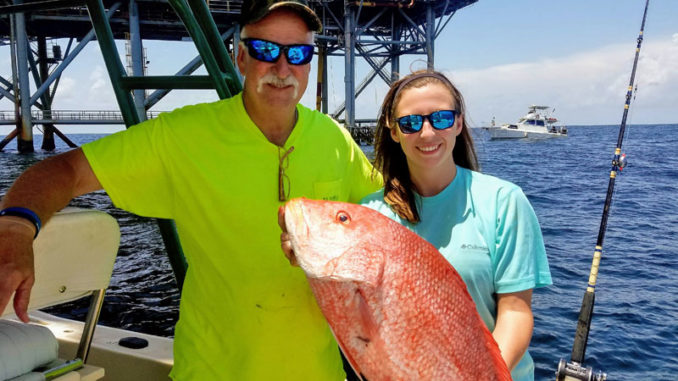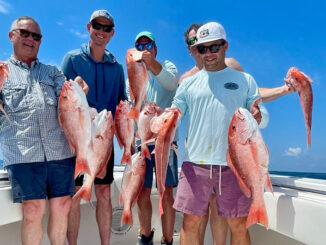
Big baits for big snapper
Capt. Art Jones of Orange Beach, Ala., said he double-hooks a big bait like a mackerel fillet that is 6 to 8 inches long and 3 to 4 inches wide.
“I’ve found that bigger baits produce bigger red snapper,” Jones said. “A bigger, tougher bait like mackerel will give you more chances to take a red snapper than a smaller bait will.”
Other big natural baits include speedo minnows (aka northern mackerel), goggle-eyed snapper or whole squids stuffed with cigar minnows.
Play that fish
Once an angler gets a snapper on the line, it’s important to know how to get that fish to the boat.
Art Jones said the key is to stop reeling when a snapper makes a run and peels off drag.
“Wait until the fish stops its run, and then begin to pump and wind — just like you will to land a marlin or a king mackerel,” he said. “As long as the fish pulls off line, you’ll know your tackle has done the job of helping you land the fish.
“When the line stops, you’ve got to pump and wind to help the tackle bring the fish to the boat.”
But once the fish gets to the boat, the battle still isn’t over.
Anglers can lose a snapper at the side of the boat for two reasons.
First, he might get the fish’s head out of the water before the first mate is ready to net or gaff the fish. When the snapper’s head is out of the water, and the boat is rocking back and forth with the waves, the weight on the line actually can help pull the hook out of the fish’s mouth.
Secondly, if the hole in the fish’s mouth made by the hook is larger than the hook, the hook will fall out of the fish’s mouth if there’s any slack in the line.
So it’s best to keep a snapper under the water until you’re ready to land it.
Use the right line
Avid red snapper guide Art Jones said the line you use has a direct relationship to the size and number of snapper you take.
For instance, he doesn’t like braided lines that have no stretch. Jones said the stretch in monofilament acts like a shock absorber: Before the drag begins to slip, the monofilament will stretch like a rubber band, which helps keep the line tight and the hook set firmly in the snapper’s mouth.
This stretching also prevents the line from breaking. Jones thinks no-stretch lines allow the snapper to jerk against the line. Because the line doesn’t stretch, a snapper will tear a bigger hole in its lips, and the hook will fall out.
So if you’re fishing for a really big snapper, don’t use no-stretch lines like braid. Instead, stick with old-fashioned monofilament.


